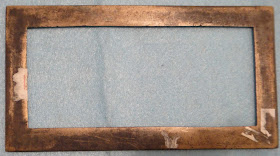This mystery object was used in the production of calligraphy. To keep the columns of characters straight, sometimes guide lines were lightly inscribed. But for those who preferred a more freehand look, these brass frames placed on the paper or silk ensured proper proportions and alignment of the characters as they were painted. They are thus among the many items that belonged in the scholar’s studio.
This was probably a difficult object to guess for those who don’t do drafting or calligraphy, but two readers used the clues and very much narrowed down the answer. Bazza directly mentioned calligraphy, and Rosemary’s mention of a template is so tantalizingly close that I have counted it as a winner.
The top example is made of cast brass, lending it some weight so that it could also be used as a paperweight, and so that it would not slip easily. The top side has a floral decoration, while the bottom is polished to lie flat against the work as it was produced.
 |
| The smooth and polished underside of the frame show that it was used directly on the paper or silk |
These frames are still very much used by those who practice Chinese calligraphy. The following screen shot take from a Google search shows them in use, and that they often come in sets of varying sizes. Notice that some have rulers stamped along the edges, as a further aid in getting the proper proportions to the characters.
These frames also helped to align the placement of the seal-stamps that were used by Chinese artists and collectors. Painters and calligraphers often sign their own productions with red seals, and collectors of fine paintings and calligraphy may add their own seals, even to famous paintings of important cultural value.
Over time, the accumulation of the stamps adds a characteristic look to Chinese paintings, a visible record of appreciation over many generations. The seals also provide a provenance, and the seal of a famous collector or emperor adds to the cachet of a work.
Zhao Meng-fu (1254-1322) was a revered Yuan Dynasty painter. His Autumn Colors on the Qiao and Hua Mountains is considered one of the greatest masterpieces of Chinese paintings. Notice how many red seals are on the painting, and how carefully they are placed. I have been fortunate to see this painting in person, and the effect of Zhao Meng-fu’s genius is truly astounding.
 |
| This famous painting has accumulated many seals over the last 700 years. To see its beautiful detail, visit the original photo in Wikipedia, then click to enlarge. |
 |
| Detail of above. Imagine the nerve it must take to add one of these seals. What if you botched it and got a red smudge on this treasure? |
The next calligraphy alignment frame sports a meander or Greek key design. It could use some cleaning up, but I am afraid that removing the paper tag would create a “clean” spot on the frame, and I certainly do not want to polish it. Usually I remove tags immediately, but this is an old one that had been on there a long time, and would not come off easily. The same is true of the paper tags on the bottom of the floral one.
My final calligraphy frame is less fancy, although it is still decorated. It has engraved trophies in the middle of the long sides, interspersed with punchwork bats and corner elements. It is interesting how the corner designs closely echo the pattern of the bats. Perhaps not as heavy as the other two, it is still somewhat substantial, as one would not want these to move easily once one started writing!
When I was learning Chinese writing, I used specially ruled paper to keep the characters somewhat in order. In great calligraphy, the apparent freedom of the artist's brush is especially admired, and although some artists use genuine freehand, who knows how many rely on mechanical aids like these decorated brass frames.
(All original objects and photos property of the author. Zhao Meng-fu painting is from Wikipedia, and the Google search is of course from Google.)







